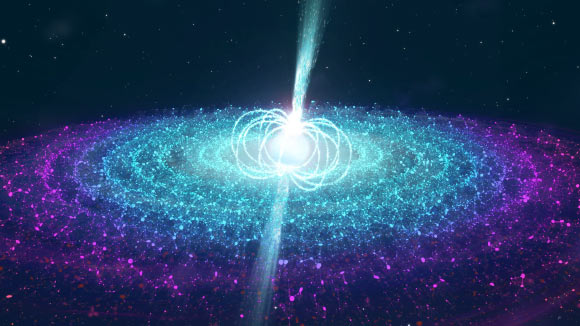Astronomers using NSF’s Karl G. Jansky Very Large Array have discovered a fast-moving jet of material propelled outward from a strongly magnetized neutron star. The discovery, reported in the journal Nature, forces rethinking a longstanding theory about the origin of such jets.

An artist’s impression of the strong magnetic neutron star Swift J0243.6+6124 launching a jet. Image credit: ICRAR / University of Amsterdam.
Neutron stars are superdense objects, the remnants of massive stars that exploded as supernovas.
When in binary pairs with ‘normal’ stars, their powerful gravity can pull material away from their companions.
That material forms a disk, called an accretion disk, rotating around the neutron star. Jets of material are propelled at nearly the speed of light, perpendicular to the disk.
“We’ve seen jets coming from all types of neutron stars that are pulling material from their companions, with a single exception. Never before have we seen a jet coming from a neutron star with a very strong magnetic field,” said Jakob van den Eijnden, an astronomer at the University of Amsterdam.
“That led to a theory that strong magnetic fields prevent jets from forming. The new discovery contradicts that theory.”
van den Eijnden and colleagues studied an object called Swift J0243.6+6124, discovered in October 2017 by NASA’s Neil Gehrels Swift Observatory, when the object emitted a burst of X-rays.
The object is a slowly-spinning neutron star pulling material from a companion star that is likely significantly more massive than the Sun.
“The magnetic field of the neutron star we studied is about 10 trillion times stronger than that of our own Sun, so for the first time ever, we have observed a jet coming from a neutron star with a very strong magnetic field,” van den Eijnden said.
“The discovery reveals a whole new class of jet-producing sources for us to study.”
The observations with NSF’s Karl G. Jansky Very Large Array began a week after the Swift discovery and continued until January 2018.
Both the fact that the neutron star’s emission at X-ray and radio wavelengths weakened together over time and the characteristics of the radio emission itself convinced the astronomers that they were seeing radio waves produced by a jet.
“This combination is what we see in other jet-producing systems. Alternative mechanisms just don’t explain it,” van den Eijnden said.
Common theories for jet formation in systems like Swift J0243.6+6124 say the jets are launched by magnetic field lines anchored in the inner parts of the accretion disks.
In this scenario, if the neutron star has a very strong magnetic field, that field is overpowering and prevents the jet from forming.
Alternatively, the team suggests that Swift J0243.6+6124’s jet-launching region of the accretion disk could be much farther out than in other types of systems, where the star’s magnetic field is weaker.
Another idea is that the jets may be powered by the neutron star’s rotation, instead of being launched by magnetic field lines in the inner accretion disk.
“Interestingly, the rotation-powered idea predicts that the jet will be significantly weaker from more slowly rotating neutron stars, which is exactly what we see in Swift J0243.6+6124,” said Dr. Nathalie Degenaar, also from the University of Amsterdam.
“A jet from Swift J0243.6+6124 may mean that another category of objects, called ultra-luminous X-ray pulsars, also highly magnetized, might produce jets,” the astronomers said.
_____
J. van den Eijnden et al. An evolving jet from a strongly magnetized accreting X-ray pulsar. Nature, published online September 26, 2018; doi: 10.1038/s41586-018-0524-1







